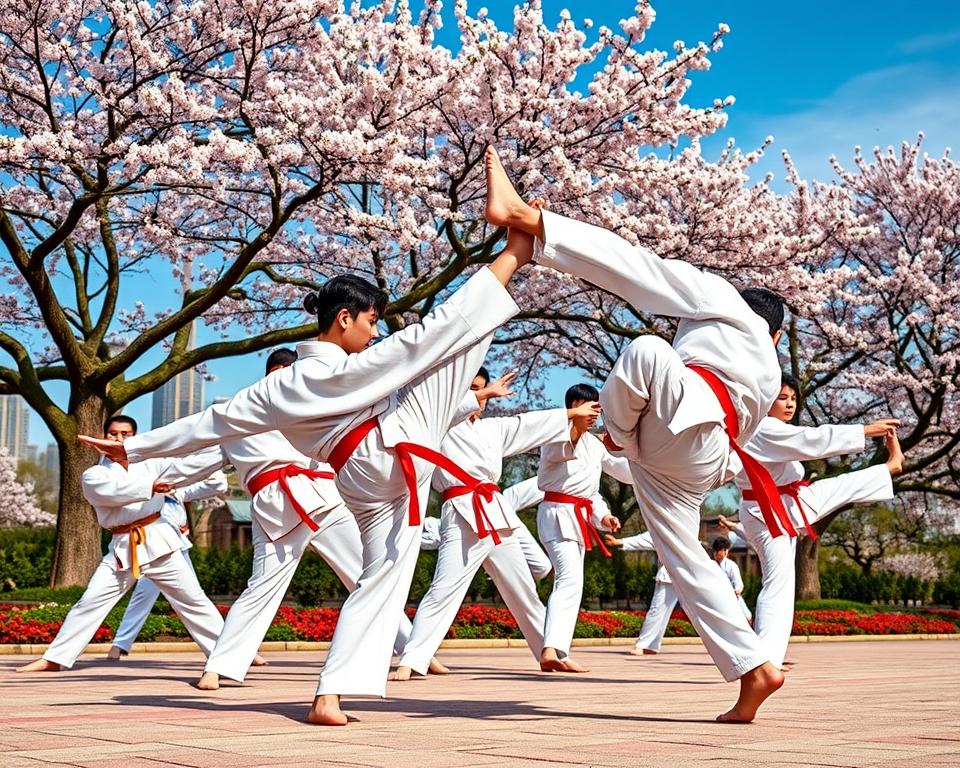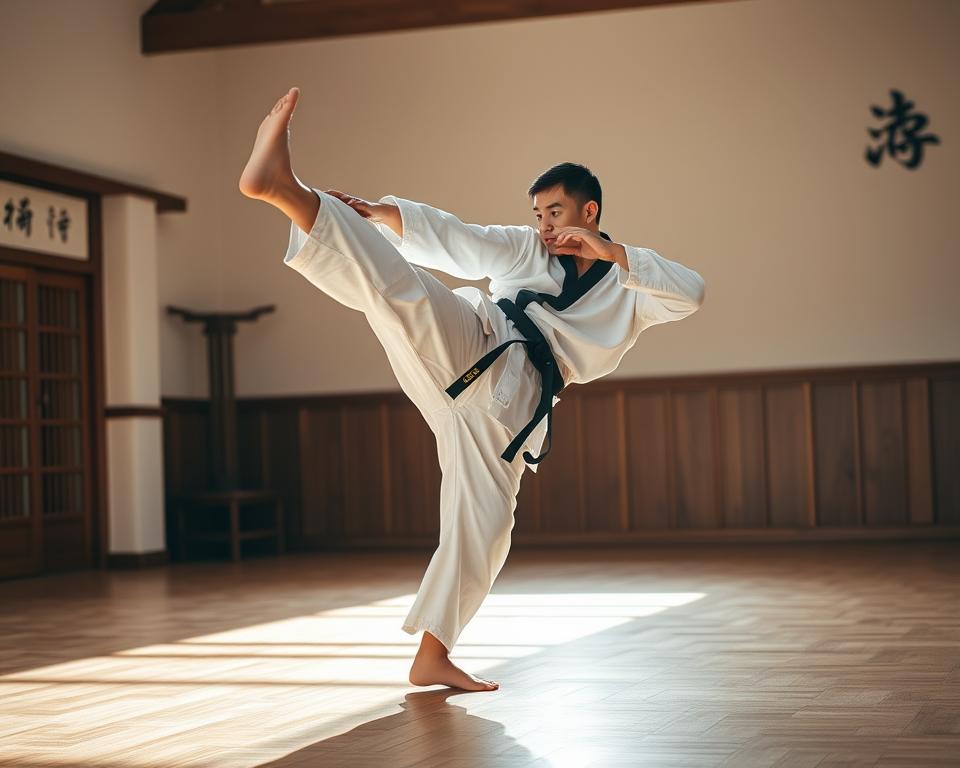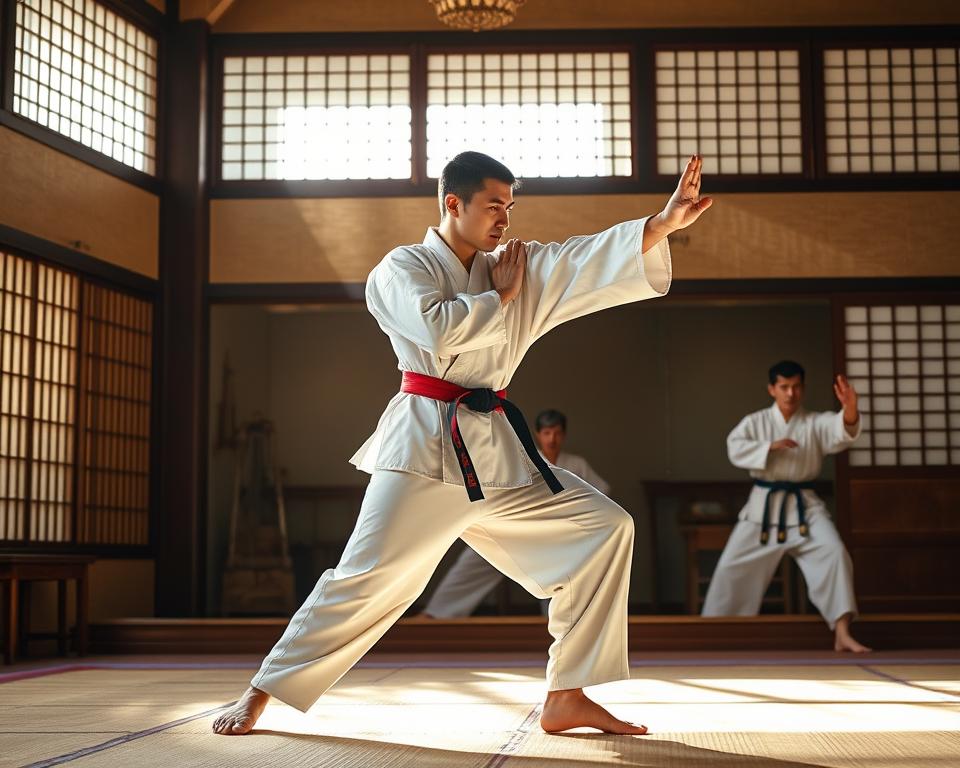Taekwondo is a dynamic Korean martial art known for its complex and beautiful forms, or patterns. These forms are more than just a show of strength. They deeply reflect the art’s core values. In this guide, we’ll explore the key techniques for mastering these forms. This will help you improve your practice and understand the art better.
Read interesting things at : vsocan
Key Takeaways
- Discover the significance of taekwondo forms in martial arts training
- Learn how to perfect fundamental stances and execute powerful kicks
- Master the art of precise blocks and their application in self-defense
- Explore the connection between taekwondo forms and the development of discipline and focus
- Understand the role of forms in the artistry and tradition of taekwondo
Understanding the Importance of Taekwondo Forms
Taekwondo forms, or poomsae, are key to martial arts training. They teach important patterns and techniques. They also help build discipline and focus in students.
By learning these martial arts training exercises, students get a deeper understanding of taekwondo. They also improve their skills overall.
The Significance of Patterns in Martial Arts Training
Taekwondo forms teach a full understanding of the art. Each pattern shows specific techniques and movements. Students must remember and do these with precision.
This method of training builds muscle memory and boosts critical thinking and problem-solving skills.
Developing Discipline and Focus Through Forms
Practicing forms makes you mentally disciplined and focused. These qualities are key for success in life and martial arts.
Performing each movement and smoothly moving between them requires focus. This helps students develop self-control, patience, and mental strength. These are valuable in all life areas.
“Mastering the forms is not just about perfecting the physical movements; it’s about harnessing the mental discipline and focus that are the true essence of Taekwondo.”
Understanding the value of Taekwondo forms helps practitioners grow deeper in the art. It also boosts their skills and personal growth.
Mastering the Fundamental Stances in Taekwondo Forms
Proper stances are key to taekwondo forms. Learning the basics like the back stance, front stance, and horse stance is vital. These stances help you stay balanced, powerful, and stable when doing techniques. This guide will help you get better at these important stances for your taekwondo forms practice.
To do well in taekwondo forms, knowing how to stand right is crucial. Let’s look at the main features of these basic stances:
- Back Stance: This stance involves a deep step back with the rear leg, putting most of your weight on it. The front foot turns a bit in, and your upper body leans towards the front.
- Front Stance: Here, your weight is split between your front and back legs, with the front knee bent and the back leg straight. Your feet are apart, and your upper body is straight and facing forward.
- Horse Stance: This stance is wide and low, with your feet apart and knees bent. Your weight is even, and your upper body stays upright and relaxed.
Getting good at these stances is key for proper body alignment, stability, and power in your taekwondo forms. By practicing these stances a lot, you’ll build a solid base. This will help you do techniques with accuracy and confidence.
| Stance | Key Characteristics | Benefits |
|---|---|---|
| Back Stance | Long, deep step with rear leg; weight on back foot; front foot turned inward | Stability, power generation, transitioning between techniques |
| Front Stance | Evenly distributed weight; front knee bent, back leg straight; feet shoulder-width apart | Balance, power generation, strong stance for strikes and blocks |
| Horse Stance | Wide, low stance; evenly distributed weight; knees bent; upright upper body | Stability, balance, foundation for generating power from the legs |
Remember, practicing regularly and paying attention to details is crucial to master the stances in taekwondo forms. With hard work and patience, you’ll get the foundation you need to do well in your martial arts journey.
“The foundation of a house is the most important part of its construction. In the same way, the foundation of your taekwondo forms is built upon the mastery of these fundamental stances.”
Perfecting the Essential Kicks in Taekwondo Forms
Taekwondo is a dynamic Korean martial art known for its powerful kicks. At its core are the essential kicks that are key in the forms of taekwondo. We’ll explore two main kicks: the roundhouse kick and the side kick.
Roundhouse Kick: A Powerful Striking Technique
The roundhouse kick, also called the turning kick, is vital in taekwondo. It involves rotating the hips and swinging the leg in a circle to hit the target. Getting the form and technique right is key to a strong kick that keeps you balanced and in control.
To master the roundhouse kick, you need good footwork, hip rotation, and core power. This kick is all about using your body’s power effectively.
Side Kick: A Versatile and Effective Move
The side kick is a key move in taekwondo, used for both attacking and defending. It’s done by stretching the leg sideways to hit different parts of the opponent. To get the side kick right in forms, you need to know how to balance, position your body, and use linear force.
Developing a strong stance and learning to transfer power from the ground is important. This helps you hit harder with your kicks.
Adding these kicks to your taekwondo forms is a big step in mastering the art. By improving your roundhouse and side kicks, you’ll show off your skills and the beauty of taekwondo.
“In taekwondo, the kicks are not just physical techniques; they are expressions of the practitioner’s spirit and mastery of the art.”
Executing Precise Blocks in Taekwondo Forms
Effective blocking is key in mastering taekwondo forms, alongside powerful striking. The low block is a vital defensive move. It helps protect against leg attacks in forms and real self-defense situations.
Low Block: Defending Against Leg Attacks
The low block is a defensive move in taekwondo forms. It guards against strikes to the lower body. With the right form and position, it can stop leg attacks like roundhouse kicks or side kicks. This sets up a chance to counterattack.
To do the low block well, you should:
- Stand wide with your weight evenly spread
- Lower your blocking arm quickly in a circle, catching the attack at waist level
- Keep your focus and body straight for precise and powerful blocking
Mastering the low block adds to a taekwondo practitioner’s defensive skills. It boosts their skill and confidence in forms and real self-defense.
“The low block is the foundation of effective defense in taekwondo. It’s a technique that demands precise execution and unwavering focus, but once mastered, it can be a true game-changer.”
Adding the low block and other defensive moves to their taekwondo forms helps practitioners improve their skills. It also helps them develop mental discipline and focus, key parts of martial arts.
Incorporating Taekwondo Forms into Self-Defense
Taekwondo forms, known as poomsae, are more than just a set of moves. They are a key part of learning self-defense. By mastering these forms, you can use their principles and techniques to protect yourself in real life.
The stances, kicks, and blocks in Taekwondo forms help you stay stable, balanced, and powerful. These skills are vital for self-defense. They help you keep your ground, hit hard, and defend well. With practice, you’ll be able to react fast and effectively to threats.
- Adapting Taekwondo stances for stability and balance in self-defense situations
- Utilizing the diverse array of kicks from forms to create distance and strike vulnerable targets
- Applying the blocking techniques from forms to deflect and counter incoming attacks
Practicing Taekwondo forms also improves your mental focus and discipline. This helps you stay calm and ready to act when faced with danger. Combining this mental strength with your physical skills can greatly improve your chances of defending yourself.
| Taekwondo Form Technique | Self-Defense Application |
|---|---|
| Low Block | Defending against leg attacks and sweeps |
| Roundhouse Kick | Striking vulnerable targets from a safe distance |
| Side Kick | Creating space and pushing back an aggressor |
By blending Taekwondo forms with self-defense skills, you can boost your ability to protect yourself. This combination makes you more confident and secure in your daily life. It’s a powerful way to stay safe.
Taekwondo Forms: A Path to Discipline and Focus
Practicing taekwondo forms is more than just physical exercise. It also helps build mental discipline and focus. This training shapes the practitioner’s mental strength. The need to repeat forms and focus on details helps build self-control and focus.
Cultivating Mental Strength Through Forms Practice
The practice of taekwondo forms, or poomsae, is a journey of self-discovery. Each time you repeat and refine the forms, you challenge your mental strength. Staying focused, controlling your emotions, and doing techniques right shows your mental discipline.
As you get deeper into taekwondo forms, you see how important discipline, focus, and mental strength are. These skills help you in life, making you face challenges with determination and a clear mind.
“Mastering taekwondo forms is not just about physical prowess; it is a testament to the mental resilience and discipline that lie at the heart of the martial art.”
Forms practice teaches you to focus your mind and ignore distractions. It helps you become more aware of yourself. This approach to taekwondo forms improves your physical skills and builds mental strength for life.

Embracing the depth of taekwondo forms starts a journey that goes beyond the physical. It helps you unlock your full potential and use your mind’s power.
The Beauty of Taekwondo Forms: Artistry in Motion
Taekwondo forms are more than just techniques; they show off the beauty of martial arts artistry. The smooth movements, precision, and choreography in taekwondo forms make this art stand out.
At the core of taekwondo is a drive for technical perfection. Practicing forms shows this dedication. Each set of moves is like a well-planned show, aiming for a mix of strength, speed, and grace.
“Taekwondo forms are a dance of discipline, where the body and mind come together in a harmonious display of artistry and martial prowess.”
The beauty of taekwondo forms is clear to see. The way practitioners do strikes, blocks, and kicks, and how they move smoothly between them, grabs the audience’s attention. Those who excel in forms turn their practice into a captivating show, highlighting the beauty of this martial art.
By practicing taekwondo forms, practitioners improve their skills and learn to value the art’s beauty. This focus on artistry in motion motivates them to aim for greater refinement, expanding taekwondo’s limits.
Whether for competition, showing off, or personal growth, taekwondo forms show the art’s beauty and discipline. Embracing the artistic side of their practice, practitioners connect more deeply with the art. This deepens their experience and encourages others to see the beauty in taekwondo forms.
Choosing the Right Taekwondo Forms for Your Level
As you move forward in taekwondo, you’ll find many forms to try. Each one is for a different skill level. Finding the right ones can be fun and a bit tricky. But, with good advice, you can pick forms that help you improve.
When picking taekwondo forms, think about your skill level. Beginners start with easy forms like Taegeuk 1 or Poomsae. These focus on basic moves like stances, blocks, and strikes. As you get better, you can try harder forms like Taegeuk 5 or Koryo. These have complex footwork, dynamic kicks, and advanced moves.
- Beginners: Start with forms like Taegeuk 1 or Poomsae to build a strong foundation.
- Intermediate: Explore more challenging forms such as Taegeuk 5 or Koryo to refine your skills.
- Advanced: Tackle complex forms like Taegeuk 8 or Kukkiwon to showcase your mastery of taekwondo techniques.
Choosing the right taekwondo forms means balancing your skill level with the form’s challenge. This approach helps you progress, gain confidence, and become a well-rounded practitioner.
“The journey of a thousand miles begins with a single step.” – Lao Tzu
By picking the right taekwondo forms for you, you’ll improve your physical skills. You’ll also work on mental discipline and focus, which are key to this martial art.
Taekwondo Forms: A Lifelong Journey
Mastering taekwondo forms is a journey, not a finish line. It’s a lifelong journey of learning and getting better. The practice of taekwondo forms grows and deepens over time. It offers chances for ongoing growth and self-discovery.
As you move forward in martial arts, forms practice keeps you interested and driven. Finding new layers of movement and meaning in each form can make your practice fresh. This is true at any level of skill.
Perfecting taekwondo forms is like climbing a mountain. The top may always seem far away. But the journey, the effort, and the small wins are where true mastery is found. With every try, your body and mind get better at the art’s fluid motions and precise moves.
See your lifelong journey with taekwondo forms as a journey, not a destination. It’s about enjoying the experiences and lessons along the way. Every challenge, insight, and step forward helps you grow as a martial artist and a person.
“The journey is the reward.” – Taoist proverb
| Lifelong Benefits of Taekwondo Forms | Desired Outcomes |
|---|---|
| Continuous personal growth | Deepening of technical expertise and understanding |
| Improved focus and discipline | Increased self-awareness and mental fortitude |
| Appreciation for the art and tradition | Embodiment of taekwondo principles and philosophy |
Embrace the lifelong journey of taekwondo forms. Let it lead you to a deeper understanding of yourself, your art, and the endless possibilities within.
The Versatility of Taekwondo Forms
Taekwondo forms, also known as “poomsae,” go beyond personal practice. They can be used in competitions and demonstrations, showing the art’s versatility. This ancient martial art is more than just moves; it’s a way to show skill and artistry.
Adapting Forms for Competition
In competitions, taekwondo practitioners show off their skills with forms. They need to pay attention to every detail and understand the movements well. They work on their techniques to make sure they’re precise and smooth.
They also focus on powerful stances and kicks. By adjusting their forms to fit the competition rules, they can improve their performance. This helps them stand out among others.
Captivating Audiences in Demonstrations
During demonstrations, taekwondo forms show off the art’s versatility and artistry. Practitioners create routines that mix traditional and creative moves. This makes the audience watch in awe at the beauty and precision of the moves.
By focusing on the demonstration side, practitioners can teach and inspire the crowd. They help people understand and appreciate the beauty of taekwondo forms.
| Competitive Adaptation | Demonstration Showcase |
|---|---|
|
|
Whether in competitions or demonstrations, taekwondo forms let practitioners show their skills. They can improve their skills and inspire others to learn about this dynamic martial art.
Mastering Taekwondo Forms: A Step-by-Step Approach
Improving your skills in taekwondo forms takes a step-by-step method. Break down the learning process and focus on the basics. This way, you can move forward and master these complex patterns of movement.
- Start with the basics: Make sure you know the key taekwondo stances, like the front, back, and horse stances. Getting these right lays a strong base for doing the forms well.
- Perfect your kicks: Taekwondo forms include various kicks, from the powerful roundhouse to the versatile side kick. Spend time improving the technique and precision of each kick. They’re key to the forms.
- Develop fluid transitions: Moving smoothly from one technique to another is vital in taekwondo forms. Work on moving without pause, keeping balance and control all the way through.
- Emphasize timing and rhythm: Each taekwondo form has its own rhythm and timing. Work on feeling the tempo and rhythm to make your performance look smooth and engaging.
- Refine your technique: Always check how you’re doing the form, looking for ways to get better. Paying attention to details will help you get more precise and skilled.
Follow this step-by-step guide and practice regularly to master taekwondo forms. Embrace the journey and let the beauty of these traditional patterns motivate your commitment to the art.
“The journey of a thousand miles begins with a single step.” – Lao Tzu
The Role of Taekwondo Forms in Traditional Martial Arts
Taekwondo forms, known as “poomsae” in Korean, are key to the art’s history and tradition. They are more than just a set of moves. They capture the heart of taekwondo as a respected discipline.
Forms are a vital part of training in traditional martial arts. In taekwondo, they connect us to the art’s roots. They keep the philosophy and culture alive that shaped it over time.
Practicing traditional martial arts forms is not just about the moves. It’s a way to share knowledge, discipline, and culture. Every step in a form has a deep meaning, showing the art’s wisdom and values.
“The true essence of martial arts lies not merely in the physical techniques, but in the mental and spiritual discipline that underlies their practice.”
Learning taekwondo forms helps practitioners understand the art’s history and core principles. This approach keeps the art true to its roots while it changes with the times.
By valuing taekwondo forms, practitioners show respect for the art’s heritage and its lessons. This practice helps them become skilled and also keeps the art’s wisdom alive.

Conclusion: Embracing the Essence of Taekwondo Forms
As we wrap up our look at taekwondo forms, it’s clear they’re more than just moves. They’re a journey that touches on the body, mind, and art of martial arts. Mastering these patterns helps you get deeper into taekwondo’s core, boosts your skills, and keeps you passionate about the art.
We’ve looked at why taekwondo forms matter, the key techniques they’re built on, and their many benefits. We’ve seen how they improve your stance, striking, blocking, and even help in self-defense. This shows how central forms are to learning taekwondo.
Starting this path has made you stronger physically and mentally. It’s also sharpened your focus and helped you see the beauty in taekwondo forms. This well-rounded approach to martial arts training lets you keep growing and staying true to taekwondo’s values. It makes your practice a lifelong journey of getting better.


